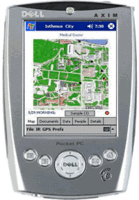GLS ARG
 Matt and I met today to talk about creating an AR game for the GLS conference. One of the thoughts that came up was: how to structure the game in such a way that part of the goal is to come up with and document (digital camera cosplay?) your own narrative (inspired by Tayler the Wanderer).
Matt and I met today to talk about creating an AR game for the GLS conference. One of the thoughts that came up was: how to structure the game in such a way that part of the goal is to come up with and document (digital camera cosplay?) your own narrative (inspired by Tayler the Wanderer). In a way, it's a lot like Phonetic Theme Scrabble in that the players are coming up with their own ideas within a larger game structure. The degree of complexity is up to the players, but the initial structure of the game is very simple. Can it be compelling? I think it can be, especially if modeled, or once you see other players get into it (a sort of competitive peer pressure).
Talking it over with Dan White this evening, he came up with the idea of having a rule that if players run into other players, they have to incorporate the other players (and/or the other players' narratives) into their narrative.
Still, we need to come up with a generic-enough idea to structure the game and start it off -- some guide to get things going, that explains why one needs to get to the different points (where they may run into other player groups).
Any ideas?

3 Comments:
In thinking further about this, I can't think of a better venue than a conference on video games for coming up with new/better ideas through an exercise/game like this.
The other thing that I think is potentially cool about this idea is that it gives them something semi-tangible (photographs), pits them against other player groups (competition), and offers them a chance to star in their own creations (theatre/performance art).
When thinking about the past ARG we have done here in Madison, two things come to mind. One is the importance that context can have in situating experience. I want to make sure that where ever we make people go, those place have a vividness and vitality in the game. For me that was the triumph of Dow Day. I was sitting in a place that had meaning, which was given to me through the media.
Having said that, I think the narrative must have a generalized form. We must allow the players to have input in making the narrative happen. Or atleast give this impression.
The next step ( I believe) in developing this game is to find our contexts. From there, we can build narrative.
Returning to thinking about Ming Fong's game and Jim's game, the next evolutionary step is to further blur the lines between the real and digital. I want the game to go beyond Human Computer Interaction, dealing with both Human to Human Interaction (performance) and senses of time. I want the game to live in the past, present and future. This I believe can happen through the development of objects and images with in the game structure that point outwards instead of solely inwards.
Post a Comment
<< Home